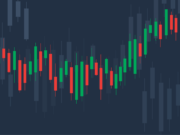Stocks rose sharply to close out the week, following an encouraging jobs report as investors consider its possible implications on future Fed moves. Friday’s rally left the major indexes (which started the session negative for the week) with a weekly gain to open the new year. The S&P 500 and the Nasdaq snapped three-week losing streaks, with gains of 1.5% and 1%, respectively. Meanwhile, the Dow stacked on around 1.5%.
January’s stock market performance has historically been a reliable indicator of what could be in store for the rest of the year. In fact, according to S&P Dow Jones Indices, 71% of the time since 1929, the S&P 500 has posted a positive return for the year after moving higher in January or, conversely, has gone on to post an annual loss when the market has declined in January.
As major banks prepare to kick off earnings season this week, analysts have been dialing back their expectations. Over the past three months, analysts reduced their Q4 EPS estimates for companies in the S&P 500 by an average of 6.5%, according to FactSet. That figure far exceeds the 3.8% average reduction seen before earnings seasons over the past 20 years. JPMorgan Chase, Bank of America, Wells Fargo, Citigroup, and BlackRock are scheduled to report on Friday. Other major companies, including Taiwan Semiconductor Manufacturing Company, UnitedHealth Group, and Delta Air Lines, will also report quarterly earnings next week.
A logical move in uncertain times is dividend stocks, which pay you to hold them. Dividend-paying companies regularly reward investors directly with a portion of the cash flow. The most desirable dividend stocks have a history of raising payouts over time as the company’s profits grow. Our first of three stock recommendations for the week ahead is a ticker with solid upside potential and tremendous dividend income potential.
Pioneer Natural Resources Company (PXD) has long viewed sustainability as a balance of economic growth, environmental stewardship, and social responsibility. Its emphasis is on developing natural resources in a manner that protects surrounding communities and preserves the environment.
In the wake of the pandemic, when energy prices were, cheap PXD struck an almost perfectly timed agreement to buy fellow Permian Basin producer Parsley Energy for $4.5 billion. If you’re wondering how PXD managed to finance that transaction, the answer lies in the fact that it was an all-stock deal that ensured Pioneer didn’t have a new giant debt load hanging over its head. The fact that Parsley operated primarily in the same region of West Texas, where Pioneer had both expertise and existing staff, has paid off over time.
That deal was a coup for Pioneer shareholders, built on the fact it was large and well-capitalized at a time when stressed and debt-reliant shale plays were looking for a white knight. On top of that acquisition, PXD also boosted its dividend by 25% at the start of the year as further evidence of its strong balance sheet.
Investors can look forward to upcoming tailwinds, including Pioneer’s recently announced partnership with the world’s largest renewable energy producer, NextEraEnergy (NEE), to develop a 140-megawatt wind generation facility on Pioneer-owned land. The project will supply the company’s Permian Basin operations with low-cost, renewable power and is expected to be operational next year.
In the third quarter, revenue was up 22% YOY to $6.09 billion, smashing the consensus estimate of 4.57 billion. The company reported earnings of $7.48 per share, beating consensus expectations of $7.27 per share. In 2022, the company has rewarded its investors handsomely with $20.73 per share through its generous 10.78% cash dividend. Chief Executive Officer Scott D. Sheffield stated, “Pioneer continues to execute on our investment framework that provides best-in-class capital returns to shareholders. This framework is expected to result in $7.5 billion of cash flow being returned to shareholders during 2022, including $26 per share in dividends and continued opportunistic share repurchases.”
Even after gaining 33% over the past year, Pioneer shares likely still have valuation upside in addition to their tremendous dividend income potential.
Taiwan Semiconductor (TSM), also known as TSMC, is at the top of the list when it comes to the semiconductor manufacturing group. The company makes chips for the likes of AMD (AMD), Nvidia (NVDA), and Qualcomm (QCOM), and it’s a key chip supplier to Apple (AAPL).
After hitting a two-year low due to a sharp slowdown in global chip demand, TSM’s share price jumped when Berkshire disclosed its more than $4.1 billion position in the stock. Still down more than 40% from its January 2021 peak, anyone on the sidelines might consider now an appropriate time to strike. “Only a small number of companies can amass the capital to deliver semiconductors, which are increasingly central to people’s lives,” said Tom Russo, a partner at Gardner, Russo & Quinn in Lancaster, Pennsylvania, who is bullish on Berkshire Hathaway and TSM.
U.S. investors have been cautious when betting on the Taiwan-based chipmaker as it would lose all Western contracts in the event of a Chinese takeover of the island. However, the company is working to reduce its geopolitical risk with a new $40 billion foundry in Arizona, expected to be operational by 2024. The investment has Washington’s support as it comes amid a U.S. push to boost domestic supplies of semiconductors and Congressional passage of the $52 billion CHIPS and Science Act.
Taiwan Semi reported $1.79 per share earnings from $20.23 billion in revenue in the third quarter, surpassing consensus expectations of $1.41 EPS from revenue of $19.96. Management reiterated its outlook of Q4 revenue in the range of $19.9 billion to $20.7 billion. The gross profit margin is expected to be between 59.5% and 61.5%. The operating profit margin is expected to be between 49% and 51%.
TSM has a 90% Buy rating from the 38 analysts offering recommendations and zero Sell ratings. Anyone on the sidelines may want to consider striking up a position in this stock ahead of the company’s earnings call, slated for Thursday, January 12th.
U.S.-based Trulieve Cannabis (TCNNF) stands out as one of the few cannabis companies that have been able to turn a steady, meaningful profit, with four years of consistent quarterly profitability under its belt. That is, up until its most recent quarter, when the company reported a net loss on the bottom line of $22.5 million, compared to the net income of $40.9 million reported for the previous year’s quarter. However, much of the loss can be attributed to one-time charges related to Trulieve’s recent acquisition of Harvest & Recreation Health. The quarterly net loss came in at around $1.1 million without the one-time charges.
While the company’s recent loss might be looked at as a step in the wrong direction, it’s common to see this following a significant acquisition. Trulieve’s cannabis revenue has been following a steady upward trajectory since well before the acquisition took place. During the second quarter, revenue increased by 49% year over year to $320.3 million.
The company has been steadily expanding operations, nearly tripling in size over the past few years. Since June 2020, when it had just 52 dispensaries, all located in Florida, the company operates 177 market-leading dispensaries throughout 11 states. It has successfully done so to preserve its position as a major player in this increasingly competitive market.
Trulieve Cannabis garners a 100% Buy rating from the 18 analysts offering recommendations. A median price target of $28.71 represents a 169.62% upside. TCNNF is one of the best picks to profit from the cannabis opportunity.
You might also like:
- Never thought I’d see this again…
- AI’s Final Frontier
- Dire AI and Nvidia warning
- Short squeeze trading 101 (208%… 202%… 82%… just in the past week)
- A.I. Gamechanger Says “$2.50 Stock Set to Breakout Overnight”
- Elon’s New A.I. Device is About to Shock the World
- Prepare Now Before This Looming $2 Trillion D.C. Shock
- Write this ticker symbol down…
- “A.I. is a Tidal Wave” – Here’s What to Buy
- #1 AI Stock for 2024 and Beyond























